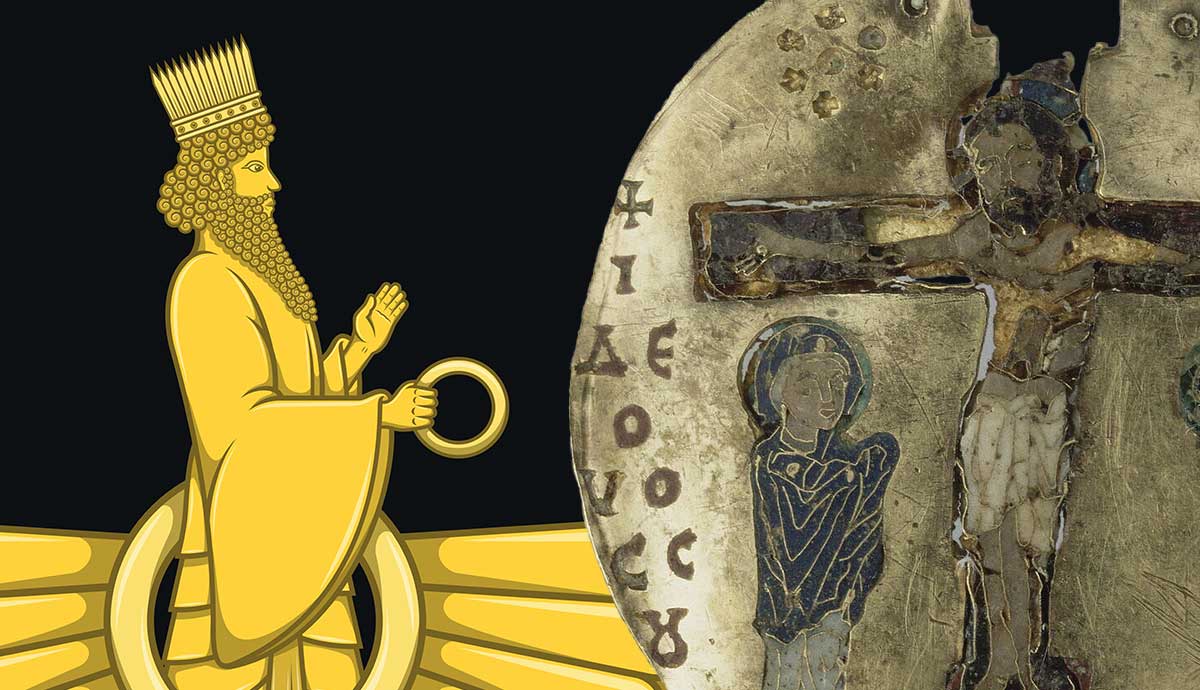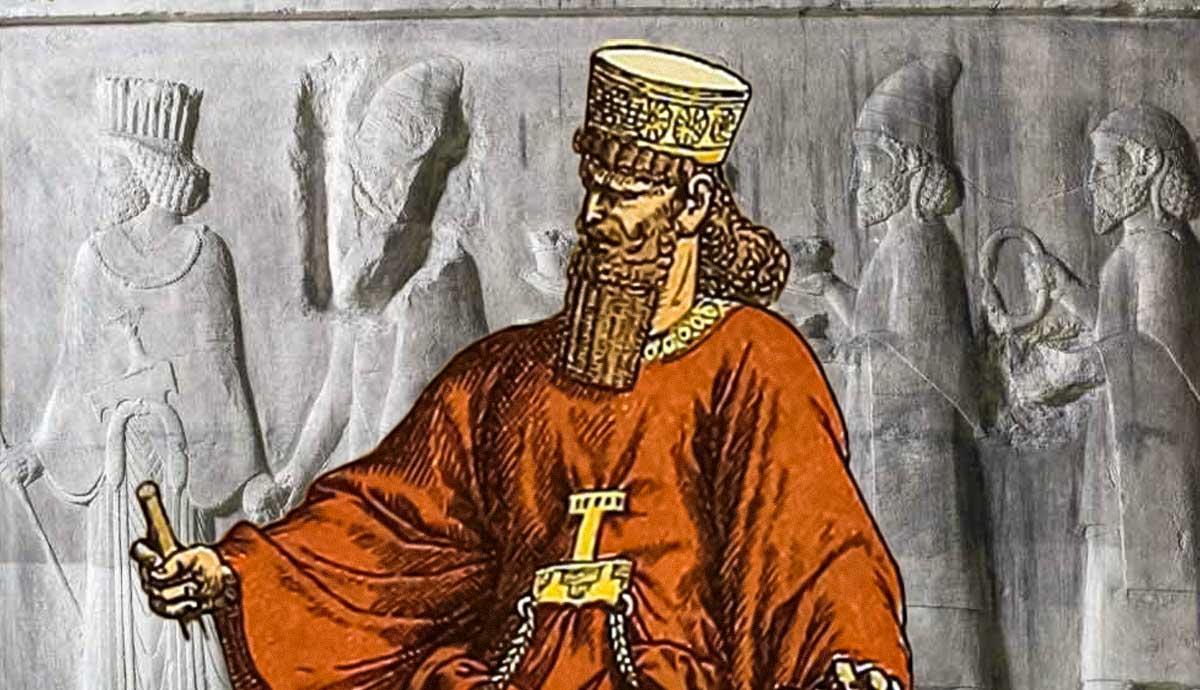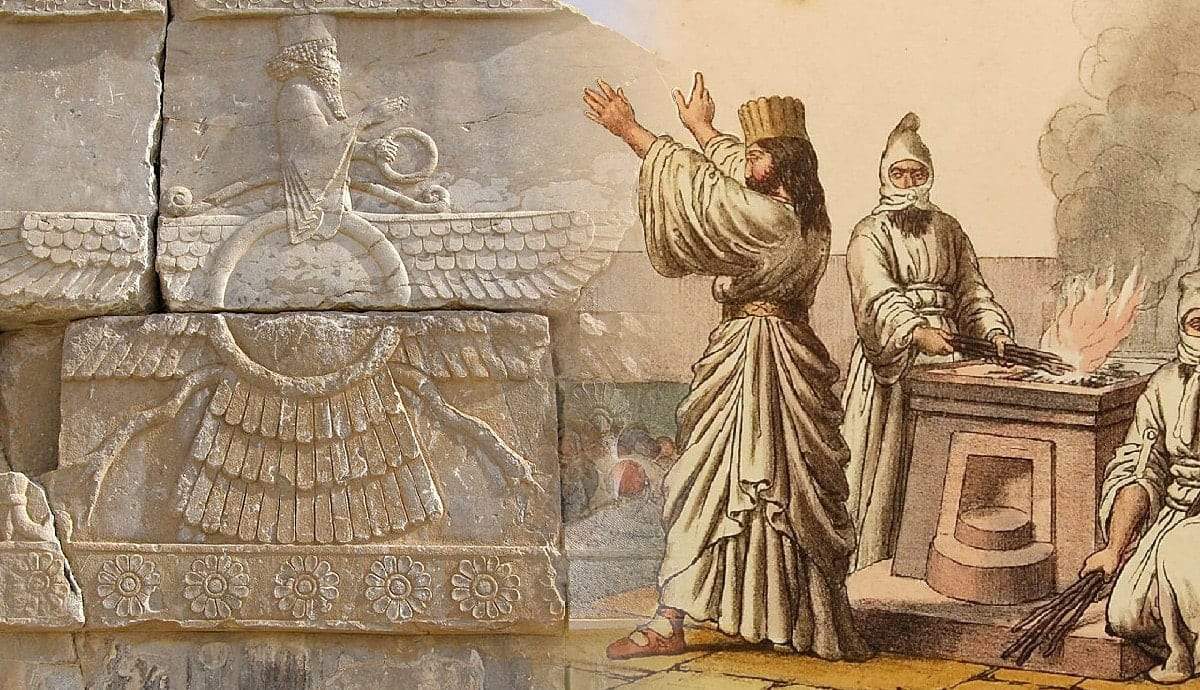
The Sasanian Empire (224-651 CE) is considered a zenith of Iranian civilization. The religion of the Sasanians was Zoroastrianism, a dualistic religion with Ahura Mazda as its principal god and champion of Good. However, Zoroastrianism was not the only religion present, as Christianity also figured prominently. Because Christianity was the religion of the Sasanians’ Byzantine rivals, Christians were initially regarded with suspicion. However, by the time of Emperor Khosrow II (ruled 590-628 CE), the Sasanians had softened their stance. Below are three examples of how Christian prophets, saints, and relics were recognized and utilized during Khosrow II’s reign.
The Prophet Daniel in Zoroastrian Iran

The biblical Daniel, from the Book of Daniel in the Old Testament, was regarded as a prophet in Christianity. Daniel, who ostensibly lived during the 6th century BCE, is best remembered for being cast into a pit of lions. The Persian emperor Darius the Great (ruled 522-486 BCE) of the Achaemenid Empire (550-330 BCE) was persuaded to do so by his jealous courtiers. However, through the power of God, Daniel survived because an angel descended from heaven and sealed shut the mouths of the lions. Daniel was thought to be buried in the Iranian city of Susa, although the tomb that exists today was constructed in the 19th century.
The 7th-century Armenian scholar Sebeos wrote in his History (14) about an incident that occurred in the city of Susa during the reign of Khosrow II. According to Sebeos, Khosrow II’s Christian wife was essential in preventing the remains of Daniel from being removed from Iran. The Byzantine Empire (330-1453 CE) was the primary rival of the Sasanian Empire, but from 591-602 CE, the two empires were at peace. During this period, the Byzantine emperor Maurice (ruled 582-602 CE) requested that Daniel’s body be delivered to him.

However, Christian Sasanians, led by Queen Shirin, protested the removal of the remains. Reportedly, miracles occurred that prevented the body of Daniel from leaving the region. The body was loaded into a carriage pulled by mules, but once the body was outside of city limits, the central spring in Susa dried up. The mules refused to continue and instead broke for the city. Because of these miracles, Emperor Maurice conceded, withdrawing his request and instead delivering offerings to the corpse, which was returned to Susa. Zoroastrian Sasanians also protested the removal. They also venerated the body, believing it to be that of a mythical king important in Zoroastrianism.

Throughout the Mediterranean and Near East, it was believed that relics, like Daniel’s body, were the physical manifestations of supernatural powers in the mundane world. Khosrow II’s protection of Daniel’s body reflected the contemporary desire to possess any possible boons and associated supernatural benefits.
Khosrow II had a more personal reason for supporting his wife, which stemmed from his close relationship with Emperor Maurice. Khosrow II inherited the throne from his father, Emperor Hormizd IV (ruled 579-590 CE). But he inherited a Sasanian Empire, including its capital, Ctesiphon, located in modern Iraq, in a state of unrest. Dissatisfied nobles had rebelled against Hormizd IV, first deposing and then murdering him. Furthermore, the disloyal general Bahram Chobin (ruled 590-591 CE) marched on Ctesiphon, declaring himself emperor. Khosrow II fled west to the Byzantine Empire.
Against the advice of the Byzantine Senate and despite the precedent of avoiding involvement in internal Sasanian affairs, Maurice decided to support Khosrow II. The armies of Khosrow II and Maurice cooperated and defeated Emperor Bahram Chobin. Khosrow II was reinstated as emperor, a position that would have been difficult to achieve without Maurice’s help.
Because Khosrow II owed so much to Maurice, his refusal to give Maurice the body of Daniel was significant. Through this, Khosrow II asserted his sovereignty in his own realm and demonstrated his willingness to protect the relics of all his subjects. That Maurice gave offerings to Daniel indicates that he was willing to recognize the Sasanian Empire’s right to a Christian relic despite their difference in faith.
Saint Sergius

When Khosrow II was campaigning to retake the Sasanian Empire, he employed prayer as a spiritual force in his war against Bahram Chobin. The 6th-century Syrian scholar Evagrius Scholasticus and the 7th-century Byzantine scholar Theophylact Simocatta both included letters related to this and similar incidents in their histories.
Scholasticus wrote in his Ecclesiastical History (6.21) that Khosrow II prayed for the defeat of one of Bahram Chobin’s generals, Zadespram. But instead of calling upon a Zoroastrian deity, Khosrow II directed his supplications towards Saint Sergius, a Christian.
Sergius was a 4th-century military saint and martyr. According to legend, he was a Christian soldier for the Roman Empire who was executed for his refusal to worship the Roman gods. The next two centuries resulted in the spread of his cult throughout the Near East. It was headquartered in the Byzantine city of Resafa in contemporary Syria.
Simocatta confirms the story in his History (5.13). Khosrow II promised Sergius that if his prayers were answered, he would send a golden bejeweled cross to Sergius’s shrine. With the head of Zadespram before him, Khosrow II bettered his vow and sent two. One was a gold cross made in Iran. The other was the same cross that his grandfather, Emperor Khosrow I (ruled 531-579 CE), had received from Resafa, then under threat of military violence by the Sasanians.

Simocatta (History 5.1) reasoned that Khosrow II’s entreaty to Sergius stemmed from “reverence for holy religion.” However, there was another, more secular, reason for his prayer. Sergius was very popular among Christian Arabs, whose assistance Khosrow II desired in his quest to defeat Bahram Chobin and reclaim the Sasanian Empire. Khosrow II’s appeal to Sergius, therefore, also appealed to Christian Arabs. But military matters cannot fully account for Khosrow II’s veneration of the saint.
Marital matters were also important because Khosrow II had defied Sasanian law to marry Shirin. As a Zoroastrian, Khosrow II was not permitted to wed a Christian, and contrary to Simocatta’s History (5.2), he never converted to Christianity. As recounted in Scholasticus’ Ecclesiastical History, Khosrow II justified his marriage through his devotion to Sergius. When Khosrow II prayed to Sergius that Shirin would conceive, he promised to send Shirin’s personal cross to Resafa if she became pregnant. His prayer was then granted, so Khosrow II sent the cross as well as other valuables.
The miracles Khosrow II attributed to Sergius may seem slight, but they offered him the opportunity to demonstrate his acceptance of Christianity as a religion within the Sasanian Empire. Additionally, Khosrow II showed he had the ability to dedicate significant amounts of treasure and gifts to a Christian shrine, just like the Byzantines with whom he had made peace.
The True Cross

But peace between the Sasanians and Byzantines did not last long. When Emperor Maurice was deposed and murdered by Emperor Phocas (ruled 602-610 CE), Khosrow II declared war on the Byzantines, ostensibly as vengeance on behalf of Maurice. This was the start of the Byzantine-Sasanian War of 602-628 CE.
While the Sasanian Empire made great territorial gains, the Byzantine Empire suffered another revolt, and Emperor Heraclius (ruled 610-641 CE) deposed and murdered Phocas. According to Sebeos (History 34), Heraclius petitioned Khosrow II for peace, but the offer was declined. In 614 CE, the Sasanians set upon Jerusalem. At the time, Jerusalem was inhabited by a mixture of Jews and Christians, with the Christian population being larger.
The Jewish population was disenchanted with Byzantine rule, which discriminated against them. They, therefore, agreed to submit to Sasanian rule as Zoroastrians were thought to be more religiously tolerant than Christians. There was precedent for this belief as it was the Achaemenid emperor Cyrus the Great (ruled 550-530 BCE) who enabled the Jews to return to Jerusalem and rebuild their temple.
According to Sebeos, after the Jewish-Sasanian pact, the Christian youth of Jerusalem attacked Sasanian officers and indiscriminately slaughtered Jews. Surviving Jews joined the Sasanian army encamped outside of Jerusalem, which then sacked the city. Sebeos numbered the dead Christians at 17,000, with another 35,000 taken captive. The Sasanians then sent the city’s gold and silver to Khosrow II. In addition to the retaliatory murders and plundering, the Sasanians also seized the True Cross.

The True Cross was a relic located in Jerusalem and thought by Christians to be wood from the very cross on which Jesus Christ was crucified. Interest in the landscape of Jesus’s death arose during the reign of the Roman-Byzantine emperor Constantine the Great (ruled 306-337 CE) with the construction of the Church of the Holy Sepulchre. Later legends expanded to incorporate the True Cross. It was an especially significant relic to Christians because the True Cross was a physical representation of how Jesus died for the sins of mankind.
Sebeos writes that after the Sasanians tore down the city walls, they arrested Saint Zacharias of Jerusalem, who was the patriarch and custodian of the True Cross. They then tortured Zacharias in order to locate it. The early 10th-century Iranian scholar Al-Tabari also wrote about the Sasanian conquest of Jerusalem in his History of the Prophets and Kings (vol. 5), providing additional details. According to him, the True Cross had been stored in a gold chest and buried in a vegetable garden. The Sasanian commander who headed the military in the region “then dug it out with his own hand” and sent it to Khosrow II as war booty.

The loss of the True Cross was a psychological and spiritual blow to the Byzantine Empire and signaled a break in Sasanian practice. In the 6th-century Strategikon of Maurice (11.1), the eponymous author writes that instead of demanding concessions in negotiations, the Sasanians made the vanquished people “voluntarily” offer the Sasanians what they wanted. This practice may have occasionally extended to the collection of significant war spoils. As described in Scholasticus’ Ecclesiastical Histories (4.28), the men of Resafa gave Khosrow I the cross from Sergius’s shrine in the hope that it would prevent further bloodshed.
The torturous search and seizure of the True Cross under Khosrow II, which was literally extracted from the earth by the leading commander, thus represented a departure from what the Byzantines had previously assumed Sasanian warfare looked like. This also perhaps contributed to the horror with which Christian and later Muslim scholars wrote about the incident.
But for Khosrow II, the capture of the True Cross signified the continued ascendancy of the Sasanian Empire in the face of the Byzantines. In peace, he had returned a cross to Sergius’ shrine, but in war, he stole a different, more important one. Zoroastrians back in Ctesiphon would likely not view the captured True Cross as a relic powerful in its own right. Rather, they would recognize the cross’s presence as a symbol of the Sasanian Empire’s might over its enemy.
The Fall of Khosrow II

Khosrow II’s victories were ephemeral. Although the Sasanian Empire expanded to its greatest extent during his Byzantine-Sasanian war, his fortunes were soon reversed. An ascendant Byzantine Empire reconquered their lost territories, invading the Iranian heartlands and threatening Ctesiphon. Khosrow II refused to admit defeat, so his own son, Kavad II (ruled 628 CE), deposed and murdered him. Emperor Kavad II swiftly sued for peace.
The Byzantine Emperor Heraclius demanded that the territories of each empire return to their antebellum borders. Additionally, Heraclius required that the True Cross be returned to Byzantine custody. Kavad II agreed to these terms. Despite the inglorious end to Khosrow II’s reign, his legacy, which included protecting the remains of the prophet Daniel, venerating Saint Sergius, and capturing the True Cross, remained. Although he maintained his Zoroastrian faith throughout his life, Khosrow II utilized the Christian faith to benefit his Christian subjects, himself, and influence his relations with the Byzantines.
Bibliography
Al-Ṭabarī, A. J. M. ibn J. (1999) The History of al-Ṭabarī Volume 5 (C. Bosworth, Trans.), State University of New York Press.
Dignas, B., & Winter, E. (2007) Rome and Persia in Late Antiquity, Cambridge University Press.
Maurice (1984) “Book XI,” in G. Dennis (Trans.), Maurice’s Strategikon, pp. 113–126, University of Pennsylvania Press.
Scholasticus, E. (1846) Ecclesiastical History (E. Walford, Trans.), Samuel Bagster & Sons.
Sebeos (1999) The Armenian History Attributed to Sebeos (R. Thomson, Trans.), Liverpool University Press.
Simocatta, T. (1986) “Book Five,” in M. Whitby & M. Whitby (Trans.), The History of Theophylact Simocatta, pp. 132–157, Clarendon Press.








